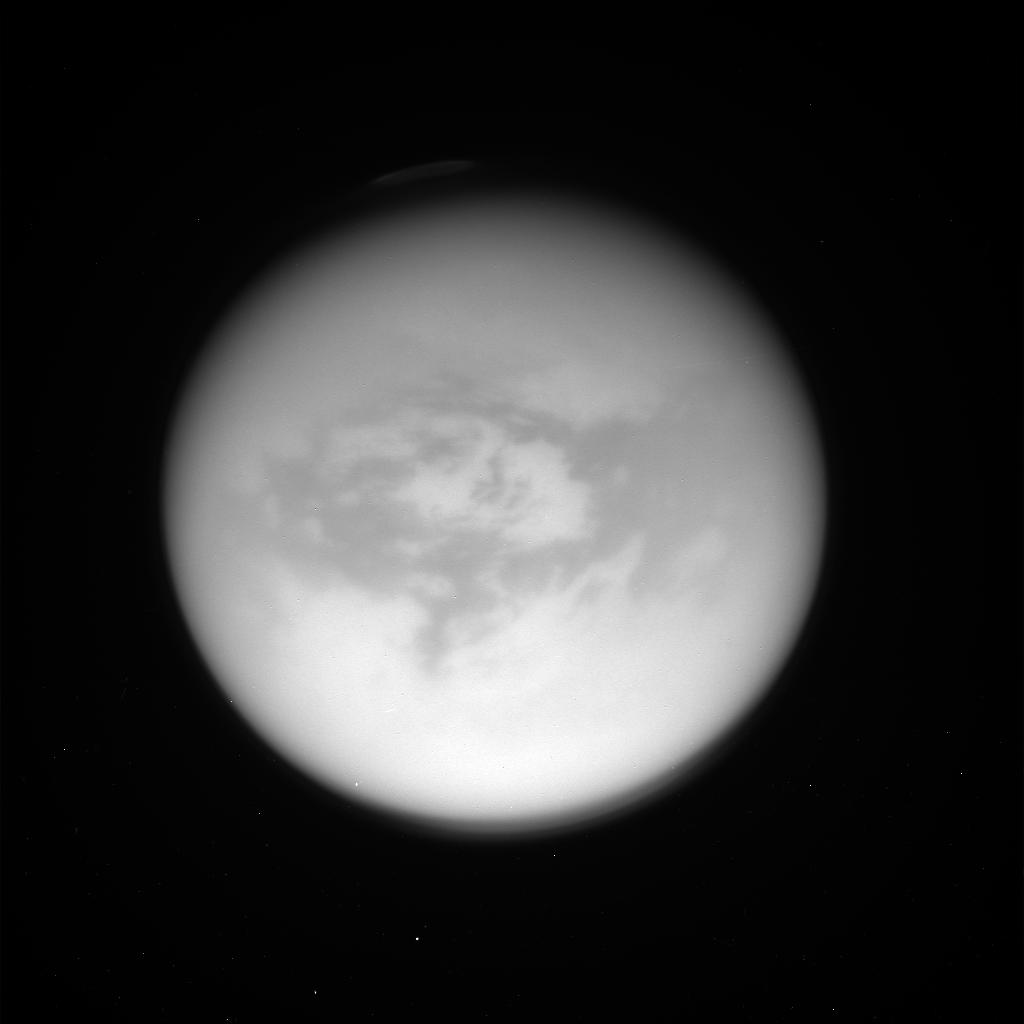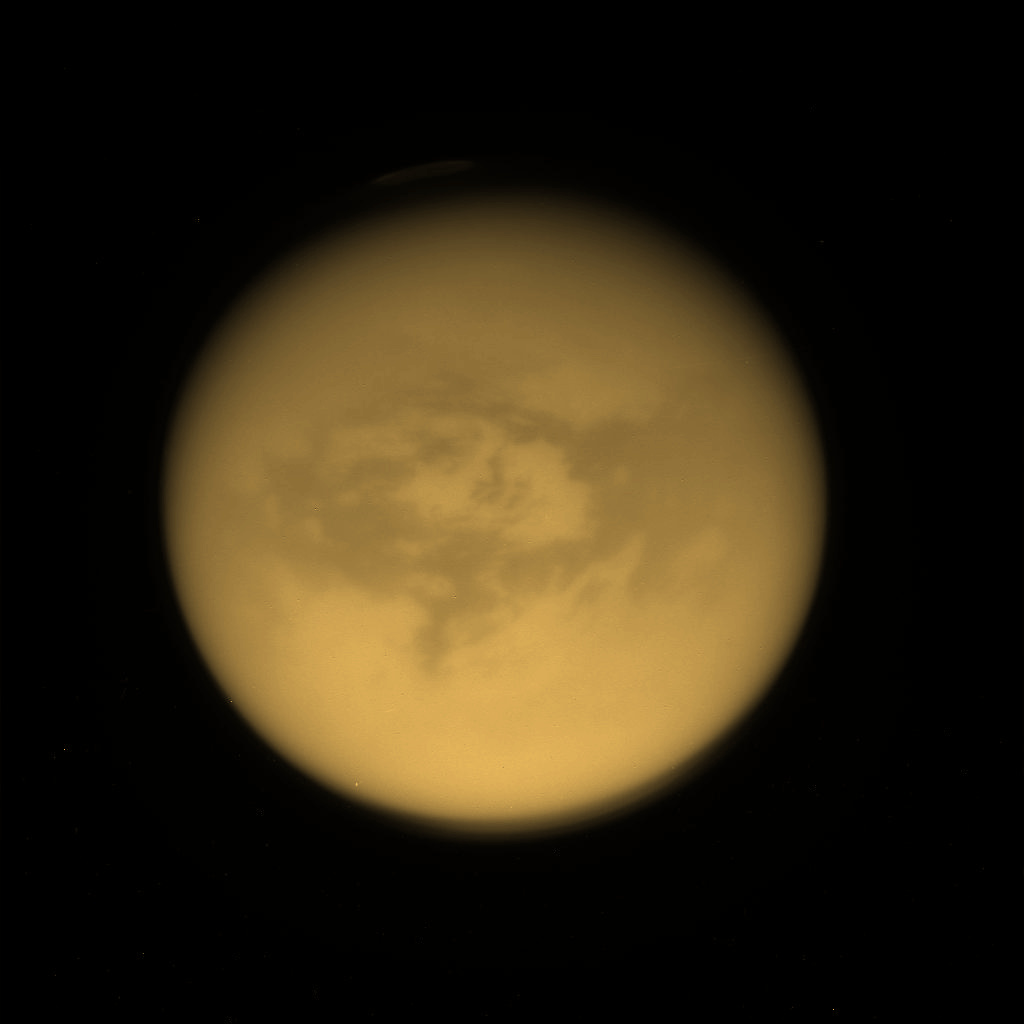February 4, 2023: An Ancient Titan Composed Of Hydrocarbon Oceans And Continents Simulated By A Global Climate Model
A new study entitled "Paleoclimate of Titan with hydrocarbon oceans and continents simulated by a global climate model", proposed by Tetsuya Tokano and published in Icarus in the volume 389 on January 1st, 2023 unveils simulations upon the climate of a potential ancient Titan composed of oceans of hydrocarbons and composed of continents. The paleoclimate of Titan simulated by the planetologist Tetsuya Tokano represents a potential climate of Saturn's largest moon one gigayear ago that is to say one billion years ago. Titan may have contained oceans of hydrocarbons as well as continents at that time. Several configurations are envisaged in the simulations of the ancient climate of Titan. The composition of the ocean can be dominated by methane or the composition of the ocean can be dominated by ethane. The simulations produced via a global climate model with a slab ocean model take into account the composition of the ocean as well as the potential presence of continents or the potential absence of any continent. The key molecules of the potential ancient oceans appear to be methane (CH4) and ethane (C2H6).
Today, the climate of Titan is really harsh due to the relatively low level of energy received from the Sun. The environmental temperature of Titan at the level of the surface is around -179 degrees Celsius, -290 degrees Fahrenheit or 94 Kelvin so that methane, ethane or even propane can appear in their liquid form on the surface. The atmosphere of Titan is currently dominated by molecular nitrogen like our own atmosphere but the second most abundant gas of the atmosphere is not oxygen on Titan. The second most abundant gas of the atmosphere of the giant moon is in fact methane. Methane can form lakes, rivers or seas on Titan. That's also the case for ethane, a molecule that is heavier than methane. The climate of Titan will be intimately linked to the size of the oceans or seas and to the composition of the oceans or seas. What will the climate be if the ocean is dominated by methane ? What will the climate be if the ocean is dominated by ethane ? The study of Tetsuya Tokano reveals that the climate over oceans rich in ethane is dry in terms of methane. The study also suggests that the climate over oceans rich in ethane is windier than the climate over oceans rich in methane.
In the configuration of an ocean dominated by ethane, the presence of continents does not significantly change the climate. Due to orographic phenomena or due to the presence of mountains, the continents are rather windier than the oceans in the configuration of oceans rich in ethane. In the configuration of an ocean rich in methane, the climate over that ocean is very moist. That climate will also be calm if there are no continents. A semi-annual variation in global-mean surface pressure of about 0.1 hPa can be generated by the global imbalance between the release of molecular nitrogen from the ocean in spring and the absorption of molecular nitrogen by the ocean in autumn due to the temperature dependence of the molecular nitrogen (N2) solubility in the ocean. In the configuration of an ocean dominated by methane in a world containing continents, the temperature contrast between the sea or the ocean and the land engenders a sea breeze circulation in summer. That sea breeze engenders intense rainfall events at the level of the mountains on windward slopes of continents. A parallel between that type of phenomenon and meteorological phenomena on Earth can be drawn obviously.
The dynamics of methane and ethane on the Orange Moon and the dynamics of water on Earth are clearly different but methane and ethane can engender familiar phenomena on Titan. There are clouds of methane or clouds of ethane on Titan. Those clouds are reminiscent of the typical clouds dominated by water on Earth. At the end of the summer period when the temperature of the sea or the ocean has sufficiently increased, higher levels of evaporation can be observed and heavy rainfall events or storms can occur. That's the case on Earth and that must also be the case on Titan. The simulations of Tetsuya Tokano reveal the potential climates that could be encountered on Titan. They clearly show that logic can allow us to discover potential worlds that we have never seen in reality and that we will never see. Titan is a good natural laboratory to study another world of seas, rivers or oceans. The contrast between the temperature of the ocean or the sea and the temperature of the land or the continent and the irregular topography of the continent engender instabilities that can engender extreme meteorological phenomena like cyclones, tornadoes or storms.
The evaporation processes will tend to be stronger at the end of the summer period engendering large cloud systems. If there are mountains close to the coast, any movement of the clouds from the sea or ocean toward the land or continent will tend to engender heavy rainfall events at the level of the mountains which tend to act as a barrier against the movement of the clouds. That's a typical phenomenon encountered on Earth like in the region of Montpellier in France where the mountains can undergo heavy rainfall events at the start of the autumn season. Those types of heavy rainfall events occurring in that period of the year are known as CÚvenol Storms because they take shape in the mountainous area of the CÚvennes. Those heavy rainfall events can produce floods in the plains or at the base of the mountains which act as a barrier against the clouds. In the harsh environment of an ancient Titan, extreme events like the CÚvenol Storms can potentially be encountered in the mountainous areas close to the coast of the methane seas or oceans. The type of topography on the continent close to the sea or ocean will tend to play a major role regarding the local meteorology.
Under the action of solar radiations, large amounts of methane can evaporate from the ocean or sea and condense to form clouds at a particular altitude. Cyclones can potentially take shape at the low or middle latitudes like on Earth. At the present time, the low or middle latitudes of Saturn's largest moon appear relatively dry. The dark areas of the low or middle latitudes tend to be dominated by Seif dunes or linear and parallel dunes extending over long distances. Therefore, the level of the potential evaporation processes of methane can't be high enough to allow the development of cyclones or hurricanes in the low or middle latitudes. However, the observations have shown that large cloud systems can appear and develop in the low or middle latitudes during the long Titanian year. That was the case in 2010 for instance, at the start of the spring season in the northern hemisphere and at the start of the autumn season in the southern hemisphere. Those clouds can potentially engender heavy rainfall events in the area. The aerial views from the Huygens probe had shown, on January 14, 2005, during the parachuted descent toward the Titanian surface, that the bright mountains of the area contained a network of dark channels.
The network of dark channels in the bright hills of the region of Adiri and Shangri-La can be found at a low latitude of the southern hemisphere. The channels likely represent drainage channels and they were probably dry at the time of the atmospheric plunge of the Huygens probe. Those channels demonstrate that it must rain from time to time in the area. During the long Titanian year which lasts almost 30 Terrestrial years, rainfall events may be quite rare. In fact, there may be seasonal rainfall events in the area of Adiri and Shangri-La. Prior to the atmospheric descent and the landing of the Huygens probe, some planetologists had imagined, on the basis of the infrared or near-infrared views from the Cassini spacecraft, that the dark areas which appear in the low or middle latitudes were probably seas or oceans of methane or ethane. The subsequent radar views of the low or middle latitudes of Titan have clearly shown that those dark areas tend to be dominated by linear and parallel dunes extending over long distances and resembling the Seif dunes encountered in the Namib Desert on Earth. Those dunes found in the low or middle latitudes of Titan may be the outcome of ancient seas or oceans of methane or ethane.
There are signs on the surface of the Opaque Moon that suggest that Titan may have been an ocean world in the past. The Huygens probe may have landed onto an ancient stream, brook or river. The aerial views taken from the Huygens probe had shown a brown plain contrasting with the bright hills containing dark channels. That plain may potentially represent the portion of an ancient sea or ocean. Currently, curiously, the seas, lakes and rivers are mostly concentrated in the high latitudes of each hemisphere. At the end of the Cassini mission in the Saturn System, the infrared or near-infrared views as well as the radar views had clearly shown that the high latitudes of the northern hemisphere represented the most humid area on that giant moon. The pools Kraken Mare, Ligeia Mare and Punga Mare appear to be key destinations for any exploration probe. Tetsuya Tokano notes that the potential presence of continents around Xanadu surrounded by oceans rich in methane can engender the type of fluvial networks observed in large amounts in Xanadu. The methane cycle of Saturn's largest moon is a major topic of research and can tell us a lot regarding the water cycle on Earth. The idea of an ocean of methane or ethane is hard to imagine but it can exist !
- To get further information on that news, go to: https://www.sciencedirect.com/science/article/abs/pii/S0019103522003451 .

